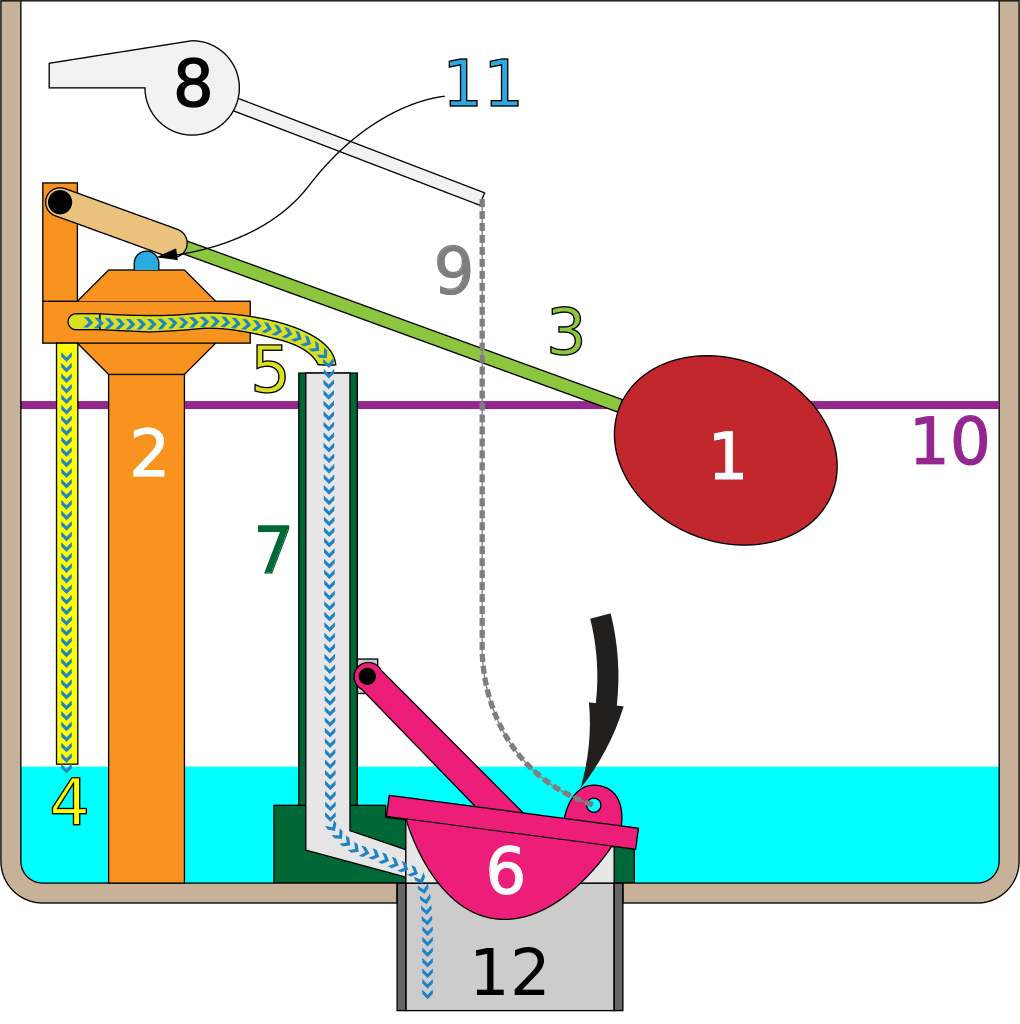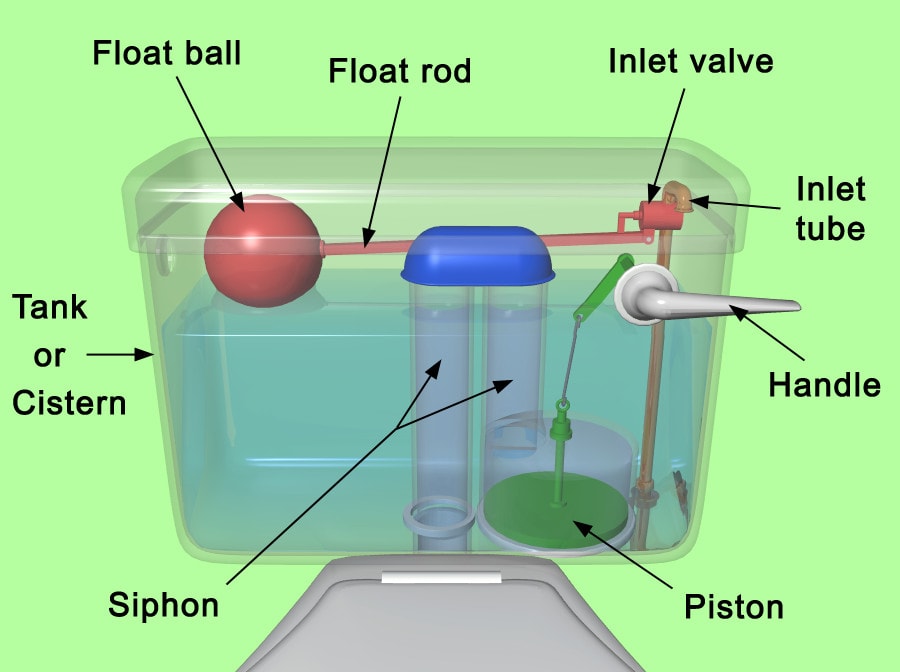Toilet flushes make up about 30 percent of your home’s water consumption. If your toilet is always running due to malfunction, you could be wasting thousands of gallons every month!
So what causes a toilet to run when you’re done using it? Here are some of the most common culprits.
In This Article We'll Discuss
#1: Water Level is Set Too High
Toilets are far more complicated than most people think. Inside your tank, several components control the flush and the subsequent tank refill.
The component that controls the water level in the tank is the float valve. Older toilets tend to have a traditional ballcock. More modern fixtures may have a sleeker floating valve.
Whatever the case may be, the valve could be set too high. This causes the water level to rise above the overflow tube! Check out the diagram below. The overflow tube is labeled as “7.”

The tube siphons water down into the bowl to ensure that your tank doesn’t cause a mess in your bathroom. When the water level is set too high, it’s a constant battle between the fill valve and the fill valve and the overflow tube!
The valve can’t reach its set height, so the water supply never turns off. This results in constant running!
Adjust your fill valve and lower it a bit. This should do the trick.
#2: Stick Float
Sometimes, it’s the floating ballcock that’s to blame. As we mentioned earlier, this valve is responsible for telling the fill valve when to turn off.
So, what happens when the floating valve gets stuck! This component needs to move freely to operate correctly. When it gets stuck due to mineral buildup or grime, it can’t trigger the fill valve to stop!
Standard ballcocks are simple to repair or replace. They consist of an inflated ball attached to a thin arm. The arm attaches to a single hinge resting on the fill valve.
Usually, it’s this hinge that’s the problem. Remove the arm and inspect the hinge. You might have to replace or adjust the screw holding the ballcock in place. Check out this video for some adjustment tips!
#3: Damaged Flapper Valve
One of the most common causes of a running toilet is a damaged flapper valve. The flapper valve is the small door on the bottom of the toilet tank.
It’s responsible for releasing that surge of water you need to drive waste away! The valve attaches to the flushing lever. So every time you push down to flush, the valve lifts up and sends water through the bowl.
Simple enough, right? Well, the simplicity of this component is also its downfall. There are a few different kinds of flappers available. But, most are rubber. The material doesn’t hold up to constant water exposure like porcelain!
Thus, flappers can deteriorate over time. They can warp, resulting in a weak seal. Limescale can damage the material, too. Without a strong seal, water will flow out of the tank and into the bowl. This causes the toilet to run more than it needs to.
Luckily, replacing the flapper valve is an easy process. All you need are a few simple tools to get the job done.
#4: Flapper Chain is Too Short
Speaking of flapper performance, you could be dealing with a chain that’s too short.
The chain for your toilet’s flushing lever needs to be long enough to reach the flapper valve. But, it also needs a bit of slack. A chain that’s too short can prevent the valve from creating a proper seal.
The same goes for a chain that’s too long. If you have too much slack, the chain could fall under the flapper valve. This would create tiny leaks for water to get through.
Ideally, the chain should have about half an inch of slack for good measure.
#5: Faulty Flushing Handle
Your toilet’s flushing handle triggers the entire flushing and refilling process. It connects to the flusher valve, which starts the fill valve.

Over time, the lever’s arm could corrode. Older handles used metal throughout the entire lever assembly. While this construction method adds durability, it makes the handle more susceptible to corrosion.
Corrosion can cause the handle to stay in the down position. This forces the flapper valve inside the tank to stay open. As a result, your toilet will constantly run in an effort to fill the tank.
To stop this issue, you’ll need to replace the handle arm assembly. Many manufacturers now offer plastic assemblies. They’re affordable and hold up well to corrosion.
#6: Leaking Fill Valve
The toilet fill valve’s job is to take water from your supply line and deliver it to the tank. It’s the first step in the refill process.
Like the rest of the components in your commode, the fill valve is not immune to damage. Small cracks can result in leaks.
Replacing the fill valve is a bit more complicated. This is a critical part of your toilet that could cause some serious damage if you don’t install it correctly. If you’re not comfortable with your DIY skills, turn to a licensed plumber.
The job doesn’t take long to complete. Once it’s finished, your tank should fill up quickly. This will stop your toilet from running too long and help you save water.
#7: Old Toilet Gaskets
Most toilets you see in homes these days are two-piece models. That means that the toilet bowl and tank are molded separately. During installation, the two parts are attached with gaskets.
These thin rubber gaskets are the only thing preventing water from leaking between the tank and the bowl! When the gaskets wear out, your toilet has to work harder to keep the tank filled.
You can get new gaskets from most home improvement stores. Replacing the gasket isn’t tough. Start by turning off the water supply and flushing the toilet to get rid of the water.
Now, remove the water supply line and loosen the bolts inside the tank. This should free the tank, allowing you to lift it up.
From there, you can remove the old gasket and attach your new one. Check out this video to learn more:
Conclusion
Did you enjoy our list of what causes a toilet to run? Let us know what you think in the comments below. Also, share our article if you found it useful!
Don’t let your toilet be the thing that drives your water bill up! If your commode is running far more than it should be, you need to take action. Use our list to identify the cause of the problem and find a solution.
Once you take care of the issue, your toilet will run smoothly and efficiently moving forward.

